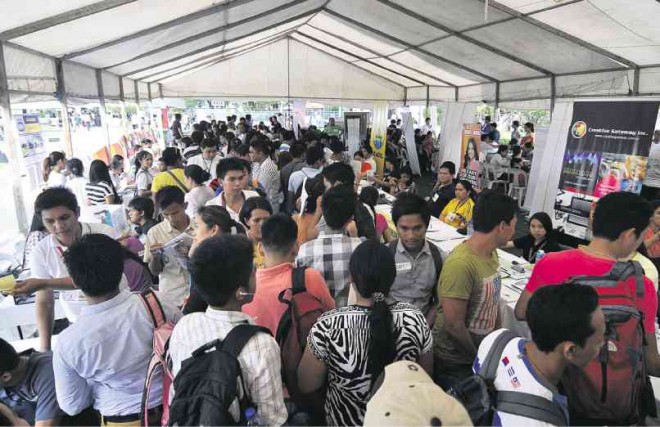The typhoons that ravaged the country at the end of last year and early this year impacted on jobs, such that the unemployment rate rose to 6.6 percent in January, the government reported Tuesday.
The Philippine Statistics Authority’s (PSA) January 2017 Labor Force Survey (LFS) showed that the jobless rate increased from 5.7 percent a year ago.
In a statement, state planning agency National Economic and Development Authority said the employment rate of 94.3 percent translated into 39.3 million employed Filipinos in January, lower than the 40.6 million employed a year ago.
“We mainly observe the employment losses in the agriculture sector, which has been affected by typhoons ‘Nina’ and ‘Auring’ that hit our country last December and January,” Socioeconomic Planning Secretary Ernesto M. Pernia said.
“The agriculture sector accounts for the second largest share of total employment at 25.5 percent, which has shed an estimated 882,000 workers or two-thirds of the employment losses,” said Pernia, who also heads Neda.
As such, “the government must focus interventions to diversify the sources of income of our workers in the agriculture sector, increase labor participation of women and address youth unemployment and underutilization,” he said.
Also, Neda said the higher unemployment rate in January was likewise partly due to temporary election-related jobs, which increased early last year ahead of the May 2016 polls.
Neda noted that the jobless rate also inched up in January 2011 or after the 2010 national elections.
Low educational attainment also figured as a reason for unemployment. “The increase in unemployed Filipinos came from those with elementary education only (up by 128,000), followed by those with high school education (up by 88,000),” Neda noted.
“Youth and adult unemployment rates also went up to 15.6 percent and 4.8 percent, respectively, but the bulk of the increase in the unemployed came from adult workers (up by 181,000),” Neda added.
Pernia expects the Duterte administration’s planned infrastructure buildup to create more jobs. “The prospects for job generation may be enhanced with the long pipeline of infrastructure projects for implementation on a 24/7 work mode basis under the current administration,” he said.
“Given that several of these projects are going to be foreign-funded, the government must see to it that foreign contractors are made to agree to recruit technical and blue-color workers who are available in the domestic labor market,” Pernia added.
Part of the plan to make the six years of the Duterte administration a so-called “golden age of infrastructure” was spending P847.2 billion or 5.2 percent of the gross domestic product (GDP) on infrastructure this year alone.
The budget for infrastructure expenditures in 2017 accounted for a fourth of the total and was 13.8-percent bigger than last year’s program.
As for high unemployment among the youth, Pernia said the administration’s development blueprint had proposed solutions to this problem. “Critical interventions to address youth unemployment are enumerated in the Philippine Development Plan 2017-2022, particularly to reduce the number of the youth who are neither studying nor employed nor in training.”


